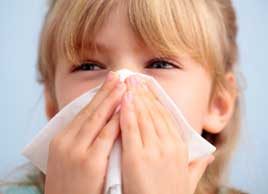6 ways to help your kid avoid the flu
Kids are often in the line of fire when cold and flu season hits. Here’s how you can help protect your child from catching the flu

When flu season strikes, your kids could be right in the line of fire. Children are usually the first in a community to get sick with influenza. They’re also more likely than adults to catch the flu when they’re exposed. And they’re usually the ones most to blame for circulating the virus. "Children play closely together, and they’re still learning hygiene," says Dr. Judy MacDonald, Calgary’s Medical Officer of Health. "They can easily spread germs from person to person."
The flu can make your little one feel pretty lousy, with its typical symptoms of fever, aches and pains, coughing and fatigue. Children with flu can suffer additional complaints like stomach pain, earaches and even convulsions.
Want to prevent your kids from catching the flu? Here are six steps that can help.
1. Get the flu shot
"My number-one advice is immunize your child against influenza," says Dr. MacDonald. This is your best bet in keeping your child flu-free: In healthy kids the flu shot is up to 90 percent effective, and more parts of Canada, like Ontario and Alberta, are offering the vaccine free. If your child is under age nine and it’s her first time getting the flu shot, she should have a second dose in four weeks. Keep in mind babies under six months of age can’t be vaccinated, so it’s a good idea to take your own shot in the arm to protect your little papoose.
2. Teach your child hand hygiene
Handwashing is another proven method of stemming the spread of germs. But it’s important to teach your kid how to wash properly: we’re talking soap and scrubbing, people. A few finger flicks under running water won’t do it. Get your child in the habit of washing before he eats, after the bathroom, and whenever his hands are dirty. Hand sanitizer is helpful on the fly, but young children need to be watched carefully to make sure they rub their hands until they’re dry. Otherwise, they may be swallowing alcohol ingredients the next time they put their hands in their mouths.
3. Stay away from sick people
Your child is more likely to catch the flu in crowded places. You may not be able to keep her out of school or daycare. But if you can avoid malls, performance halls and even public transportation, you’ll reduce her odds of picking up flu germs. Don’t allow close contact between your child and someone you know is sick.
4. Don’t be a carrier
According to the Canadian Paediatric Society, kids can often catch the flu from their carrier parents. If you already have one child who’s sick, you can unwittingly pass germs to another child just by doing your regular mom or dad duties: wiping noses, holding hands, changing diapers or preparing food. Try to keep the risk to a minimum by washing your hands frequently. Use household disinfectant to clean any surfaces like taps, door handles or toys that you or the flu-infested family member may have touched.
5. Humidify your home
There’s a lot of scientific evidence that the flu virus survives best in low-humidity environments. That’s one of the reasons why it spreads in winter, when the moisture level in our indoor air is down. Now a new study at the Harvard School of Public Health suggests that humidifiers in the home may help to kill off the flu virus. More research is needed, but the study gives an ideal target range of 40 to 60 percent relative humidity.
6. Encourage your child to exercise
If you want to help your child fight off the flu, make sure he gets regular exercise. That’s something that may slide in winter months, when kids aren’t outdoors as often. But moderate physical activity has been shown to boost the immune system. "The healthier you are, the better able you are to deal with anything that comes up, including the influenza virus," says Dr. MacDonald. Look for opportunities for indoor activity, like swimming or gymnastics. If your child takes up outdoor winter sports like skating, do take cold-weather precautions: He needs warm clothing, proper nutrition and hydration, and sunscreen.
Don’t miss out! Sign up for our free weekly newsletters and get nutritious recipes, healthy weight-loss tips, easy ways to stay in shape and all the health news you need, delivered straight to your inbox.




